Many people think that the most important stage in a sale is when a customer hands over the money. But actually, when it comes to how to influence consumer behavior, every single step in the consumer decision-making process plays an important role. For businesses to maximize profit, it’s imperative that they pay attention to every stage in the buying process.
Consumers don’t just decide to buy. Their buying behavior is determined by many different factors. And too many businesses focus on optimizing certain steps — improving checkout, acquiring customers through SEO or PPC, etc. — without looking at the big picture.
But before you can start optimizing or using strategies like UGC to support the buyer journey, you have to understand each and every stage. Here’s what you need to know about the decision making process for shoppers.
What Is the Consumer Decision Making Process?
The consumer decision making process is the process by which consumers become aware of and identify their needs; collect information on how to best solve these needs; evaluate alternative available options; make a purchasing decision; and evaluate their purchase.
Understanding the consumer decision making process is important to any business, but eCommerce businesses have a unique opportunity to optimize it. Because online shoppers generate so much more data than those in brick-and-mortar stores, online retailers can use that data to implement conversion strategies for every stage of the process.
customer decision making
The 5 Stages of the Consumer Decision Making Process — And How to Optimize
It’s important to note that the consumer decision making process has many different names, including but not limited to the buyer journey, buying cycle, buyer funnel, and consumer purchase decision process. But all the names essentially refer to the same thing: The journey a customer goes through when making a purchase.
So, here’s a breakdown of what happens in each step:
- Need recognition (awareness): The first and most important stage of the buying process, because every sale begins when a customer becomes aware that they have a need for a product or service.
- Search for information (research): During this stage, customers want to find out their options.
- Evaluation of alternatives (consideration): This is the stage when a customer is comparing options to make the best choice.
- Purchasing decision (conversion): During this stage, buying behavior turns into action – it’s time for the consumer to buy!
- Post-purchase evaluation (re-purchase): After making a purchase, consumers consider whether it was worth it, whether they will recommend the product/service/brand to others, whether they would buy again, and what feedback they would give.
Now, to show you how these stages of the buying decision process play out in real life, here are consumer buying process examples that outline each of the steps and ways for your eCommerce brand to maximize results during each stage.
1. Need recognition (awareness)
The need recognition stage of the consumer decision making process starts when a consumer realizes a need. Needs come about because of two reasons:
- Internal stimuli, normally a physiological or emotional needs, such as hunger, thirst, sickness, sleepiness, sadness, jealousy, etc.
- External stimuli, like an advertisement, the smell of yummy food, etc.
Even if the core cause is vanity or convenience, at the most basic level, almost all purchases are driven by real or perceived physiological or emotional needs. The causes for these stimuli can be social (wanting to look cool and well dressed) or functional (needing a better computer to do work more effectively), but they speak to the same basic drivers.
We buy groceries because without food in the house, we’ll be hungry. We buy new clothes because we’ll be cold, or we feel like everyone else has the latest handbag of the season, and we don’t want to be left out.
Example: Looking for a new camera
Think about it: Why does someone start looking for a new camera? Likely, their old camera isn’t working well anymore, or they simply want a nicer camera. Maybe they have a vacation coming up. Or maybe they want to give the camera as a present to their sister, who just had her first child.
How in the world is this related to a physiological need? Simple. Without a camera, they won’t be able to document special moments; therefore, they have an emotional desire to save these moments so that they are happy and not sad.
This emotional desire is the internal stimuli in this situation. Sure, a camera isn’t a life necessity keeping them from surviving, but it does solve a core emotional need.
What happens after someone identifies a need? They begin looking for a solution! Which brings us to the next step in the customer journey: searching for information.
2. Search for information (research)
As soon as a consumer recognizes a need and begins to search for an answer, you must be there to help! And where do consumers generally go to look for answers today? Google!
Example: Researching cameras
Now that the customer has realized a need to get a new camera, it’s time to find solutions to his problem. In this stage, it’s imperative that you are visible to the consumer searching for an answer.
Here are some things a consumer may be searching for:
- Best cameras 2020
- What is the best affordable camera?
- Which cameras are top-rated?
The amount of information a customer needs to search for depends on how much he already knows about the solutions available, as well as the complexity of choices. For example, let’s say there’s someone looking for a camera as a gift, and he has no idea which type of camera he wants, or what features he needs.
He will need more information than someone who already knows exactly the type of camera he wants to buy, but just needs to find the right product and the right way to purchase it.
The amount of searching necessary is entirely dependent on the situation, and it can vary widely.
So how do customers search for information? By using internal information (their previous knowledge of a product or brand) as well as external information (information about a product or brand from friends or family, reviews, endorsements, press reviews, etc.).
The biggest way you can optimize your online business during the need recognition and awareness stage is by making sure you show up in search results — and that what the consumer sees makes an impression.
Strategies to optimize during the research stage
First, make sure you’re optimizing your eCommerce storefront to rank for the keywords that matter to your brand. Check out our complete guide on eCommerce SEO.
Once you know how to strategize your SEO, you’ll want to make sure your results are well optimized to convert. User-generated reviews can help you to build brand awareness during the research stage. In fact, it’s one of the most effective ways to do it.
Reviews can help your store get seen in search results by increasing the likelihood of your store showing up for long-tail keywords. Reviews improve SEO because they give your online business a steady source of keyword rich, relevant content.
So when someone opens up their laptop and starts searching for a new camera, reviews will help you be there:
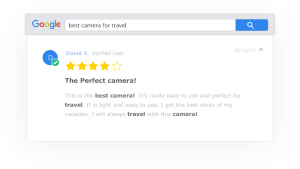
Online businesses that use reviews see an increase in search traffic. You can leverage reviews in Google Rich Snippets and Product Listing Ads so that if a customer searches in Google, you’ve added credibility to your listing. Businesses that show reviews in their search results stand out from the competition!
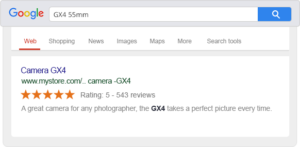
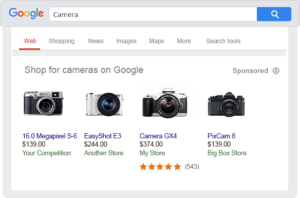
3. Evaluation of alternatives (consideration)
Now that the consumer has done research, it’s time to evaluate their choices and see if there are any promising alternatives. During this phase, shoppers are aware of your brand and have been brought to your site to consider whether to purchase from you or a competitor.
Consumers make purchase decisions based on which available options best match their needs, and to minimize the risk of investing poorly, they will make sure there are no better options for them.
Their evaluation is influenced by two major characteristics:
- Objective: Features, functionality, price, ease of use
- Subjective: Feelings about a brand (based on previous experience or input from past customers)
Example: Comparison shopping for a camera
If you’re a camera seller or brand, your goal in the consideration stage is to convince customers your camera is the best choice. And the most effective way to do that is to keep them on your site longer and find ways to earn their trust.
Consumers will first weigh the objective characteristics of your camera. Does it have all the features I want? Is it easy to use? Is it in my budget? Then, the subjective consideration will kick in: Do other people think it has all the features it should? Has anyone else who bought it expressed any difficulty with learning how to use it? Is it generally considered a good value for the money?
You only have one shot – so you need to make the most of it. Of course, it’s important that your site is informative, your prices are competitive, your value is clear, etc. But if you’re identical to a competitor in every single way, the word of previous customers is what will set you apart.
Strategies for optimizing in the consideration stage
In this stage, use reviews and user-generated content examples on your site to increase engagement and boost customer trust.
The first place you need to have reviews is on your home page, so as soon as customers land on your site, they see content from past buyers. You also need to display reviews on your product pages, so customers looking for information can see trustworthy input from past buyers.
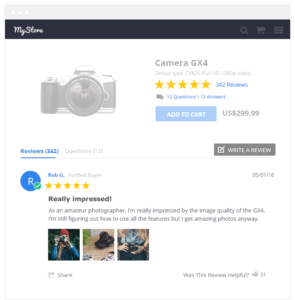
Additionally, using reviews in a home page carousel reduces bounce rate while increasing time spent on site and page views. That boost in engagement increases the likelihood that customers will learn more about your store and leave your site with a positive memory of your brand.
Reviews also help kick start the navigation to other product pages. Make sure to get reviews on a wide variety of products in order to increase click throughs from category pages into product pages.
Also, community questions and answers are another powerful type of user-generated content that can help answer shoppers’ questions so that they have no reason not to buy from you.
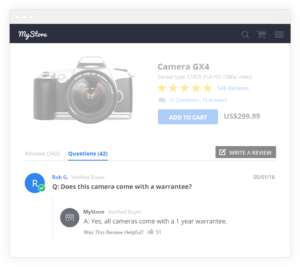
4. Purchasing decision (conversion)
Alright, now it’s money time. This is the stage when customers are ready to buy, have decided where and what they want to buy, and are ready to pull out their credit cards.
But wait! Not so fast. You can still lose a customer at this stage. This is the stage when the purchasing experience is key – it’s imperative to make it as easy as possible.
Example: Abandoning checkout for a camera
Let’s say your potential customer has gotten to the checkout stage of his purchase, and has second thoughts: What if the recipient wants a different camera? What if this camera is missing a key feature that the recipient would want? How difficult will it be for the recipient to return the camera if it doesn’t meet their needs?
This shopper will likely abandon his cart, and go back to the research stage. Maybe he’ll end up back on your site, but maybe he won’t. Your goal at this stage is to get him to complete the purchase now, so you don’t lose him forever.
Strategies for optimizing in the conversion stage
Many businesses choose to display reviews on checkout pages. This can be effective if done correctly. You need to focus on building trust, but don’t distract the customer from completing the purchase.
If you want to display user-generated content during checkout, use site reviews rather than customer photos or product reviews, and make sure they aren’t clickable. You want to focus on building trust and not distracting.
5. Post-purchase evaluation (re-purchase)
In this stage of the consumer purchase decision process, consumers reflect on their recent purchase. They think about how they feel about it, if it was a good investment, and most importantly, if they will return to the brand for future purchases and recommend the brand to friends and family.
In this stage, you need to have a post-purchase strategy to increase the likelihood that customers will engage with your brand again in the future. Return customers account for 1/3 of a store’s total income on average, so make sure you’re not missing out on this super valuable opportunity to increase your eCommerce conversion rate by turning shoppers into repeat buyers.
Example: Getting feedback and encouraging repeat purchases
In the camera example, the customer has already bought from your brand and they’re evaluating their purchase. This is usually when they will leave a review about their experience. This is also when they are at their most engaged with your brand, and they can be susceptible to strategies that encourage long term engagement.
At this stage, you want to ensure that customers buy again, and you want to encourage them to leave UGC that helps other buyers in the future.
Strategies for optimizing in the conversion stage
While your customer might take it upon themselves to leave a review, they’re far more likely to do so if you request one. Asking customers for reviews about their experience in a post-purchase email not only gives you insight into your performance, but it also gives you valuable user-generated content to leverage to attract future customers.
It’s important to remember that customers have already given you something very valuable: their money! So you don’t want to ask for too much when requesting feedback. In order to encourage customers to write reviews, make it as easy as possible for customers to leave feedback:
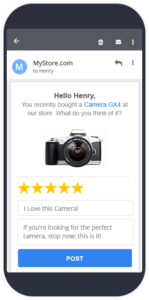
You can also use this email to cross-sell other items. Data from over 2,000 stores shows that 27.5% of customers who see promoted products in post-purchase review request emails end up converting – and these customers are valuable.
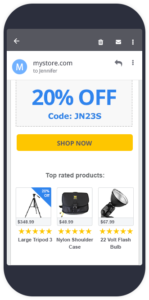
After purchase, it’s also a good opportunity to promote your loyalty program. Customers in loyalty programs consistently provide a higher lifetime value than those who aren’t because the programs are designed to incentivize purchases.
What Is the Importance of Pricing in the Consumer Buying Process?
One common question that eCommerce brands will ask is how consumers factor price into their buying decisions. When consumers are evaluating a product, price is of course a huge factor. But it’s not just about the product price — it’s about the entire cost of the purchase.
Let’s say your cameras are a good value for the money, competitively priced, and have decent reviews. What happens when your customers get to checkout, and see that you have a high shipping cost? Instead of completing the purchase, they are going to see what the shipping cost is on the other cameras they were considering. And what if one of them offers free shipping? You may lose that customer. So how does a consumer know whether a purchase may be a good deal?
You don’t want shoppers to be surprised by any additional costs when they get to checkout. Make sure to calculate taxes and shipping costs before they get to the final step. The more transparent you can be about your pricing up front, the more likely you’ll be to complete the sale.
If you want to turn a potential customer into a loyal brand advocate, it’s important to build trust and keep them engaged at every step of the process. User-generated content is a powerful tool for building brand awareness, highlighting the best things about your products, and ultimately, growing your bottom line.



